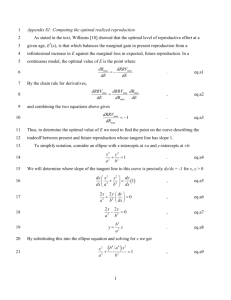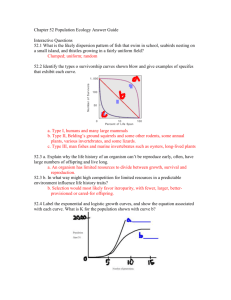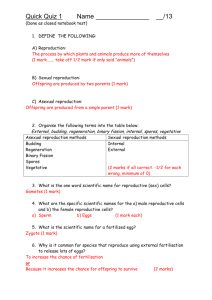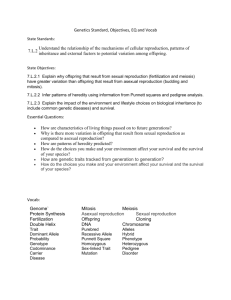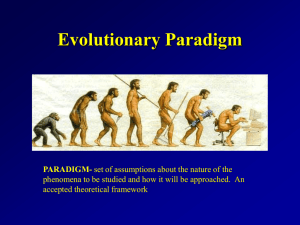Population Ecology
advertisement
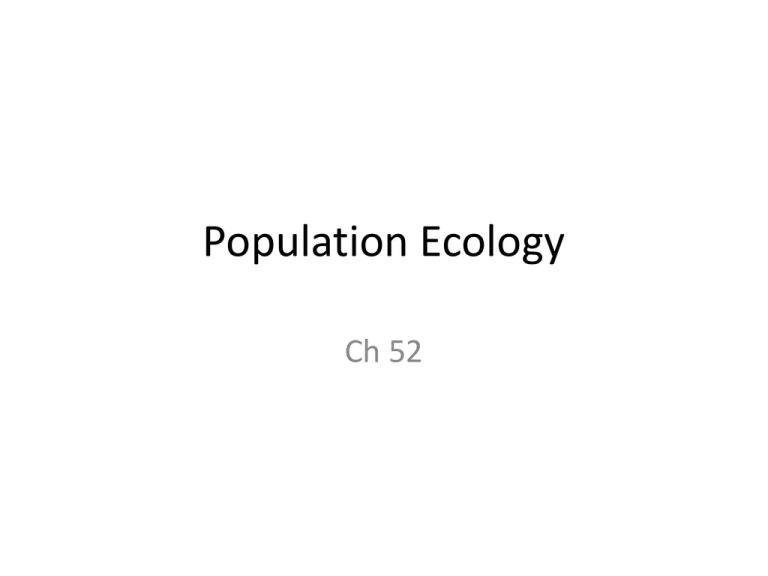
Population Ecology Ch 52 Population • A group of individuals of a single species living in the same geographic area • How to describe populations: • Density - # of individuals per unit area • Dispersion – the spacing between individuals in an area • Demographics – study of vital statistics of populations and how they change over time Patterns of dispersion Uniform, clumped, or random? • Clumped • – due to resources, mating, defense • Uniform • – often due to competition for resources by same species • Random • – in absences of strong attractions or repulsions between individuals Demographics • Birth rates & death rates • Patterns of life expectancy • Life tables – summaries of the survival pattern of a population Idealized survivorship curves Type I – most individuals die late in life (humans, elephants) Type II – constant death rate over lifespan (coral, birds) Type III - large decline in young (plants, fish) Exponential model • Population growth in an ideal environment – Abundant resources – No external restrictions • Density independent growth • Change in population = • Births + Immigrants – Deaths – Emigrants • Ignore immigration, emigration • Per capita birth rate – per capita death rate = per capita rate of increase rmax – maximum per capita rate for the species, under ideal conditions J shaped exponential growth curve • Current world population: 7.3 billion • http://www.ibiblio.org/lunarbin/w orldpop • Current world r value = 1.2% birth rate – 19.95 births/1,000 people death rate - 7.9 deaths/1,000 people Doubling time = 70/% growth rate At current r value – by 2050, population will grow to 9.6 billion people http://www.npr.org/2011/10/31/14181 6460/visualizing-how-a-populationgrows-to-7-billion Which age structure diagram represents – Italy, Kenya, and US? • Darwin calculated that if you started with 2 elephants and exponential growth, after 700 years the world population of elephants would be 19,000,000 • Why hasn’t this happened? available resources competition for these resources • Resources are limited in the real world Logistic Model • K = carrying capacity – The maximum size that a particular environment can sustain S-curve Lab population of flour beetles Life history • What determines an organism’s reproduction & survival • 3 main variables: – When reproduction begins – How often the organism reproduces – How many offspring produced per reproductive episode – There is a trade-off between present & future reproduction Evolution & life history • Natural selection maximizes total lifetime reproductive output • Single, massive reproductive episode • Don’t need resources for future survival & reproduction • Repeated reproductive episodes • Produce fewer but larger offspring each time, provide more resources for offspring “Big Bang” reproduction • Semelparity • Pacific Salmon – produces thousands of eggs in single reproductive opportunity • Annual plants, all grain crops • Spiders • Death may occur after single reproductive event • Advantageous if adult survival rate is low Repeated reproduction or “bet-hedge” • Iteroparity • Some Lizards - few large, nutrient containing eggs each year • Perennial plants • Most mammals, all birds, most reptiles, most fish • Advantageous in highly variable conditions that affect juvenile survivorship Factors for evolution • Survival rate of offspring • Likelihood that adult will survive to reproduce again • Low survival of offspring – highly variable environment – big bang • More dependable environment - repeated Trade offs • Trade offs due to limited resources • between the number and size of the offspring • Between reproduction & survival K- selection • Density dependent selection • selection for traits that are sensitive to population density, and favored at high densities • Mature trees at old-growth forests • In stable environments, organisms tend to make fewer “expensive” offspring r- selection • Density independent selection • selection for traits that maximize reproductive success in low density (uncrowded) environments • Weeds • In unstable environments, organisms tend to make more “cheaper” offspring Extreme r & K selection R K Unstable environment, density independent Small organisms Stable environment, density dependent Larger organisms Energy used to make each individual low Energy used to make each individual high Early maturity Short life expectancy Individual reproduces once Late maturity Long life expectancy Individuals reproduce repeatedly Type I & II survivor curve Type III survivor curve Density independent factors Not affected by density of population Natural disasters i.e. drought, temperature extremes, hurricanes Density dependent factors Dependent on population density - competition for resources - predation - toxic waste – i.e. ethanol produced by fermentation in yeast -intrinsic factors - i.e. hormonal changes that delay sexual maturation & depress immune system in whitefooted mice -territoriality - disease Population dynamics • Fluctuations in populations Practice problems • • • • If carrying capacity = 500 individuals Population size (N) = 300 Maximum rate of increase (rmax) = 1.0 Solve for: K-N K • Per capita rate of increase = (rmax)( K-N K ) • Population growth rate = (rmax)(N)( K - N ) K Practice problems • • • • If carrying capacity = 500 individuals Population size (N) = 400 Maximum rate of increase (rmax) = 1.0 Solve for: K-N K • Per capita rate of increase = (rmax)( K-N K ) • Population growth rate = (rmax)(N)( K - N ) K
